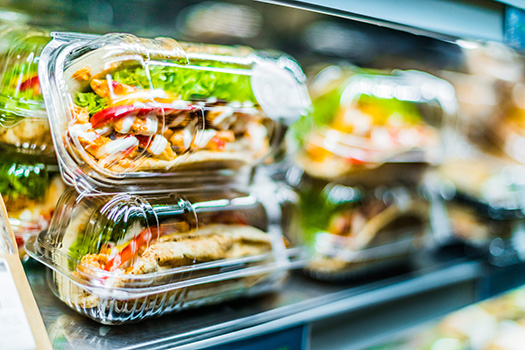Resource-efficient recycling for PET trays

In addition to its use in the production of beverage bottles, polyethylene terephthalate (PET) is also found in packaging trays used for both food (meat, fish, fruit and vegetables) and non-food items. Although an established and successful recycling concept already exists for PET, the PET trays are not recycled to a high standard. Instead, they are sorted into PET fractions in lightweight packaging sorting plants and then a significant portion of them are sent for energy recovery.
This is partly due to the fact that many PET trays have a high proportion of foreign plastic, e.g. PE, EVOH, EVA and PUR, which has a negative impact on the processing plants for PET bottles. Furthermore, the dual systems do not distinguish between food and non-food trays. This makes it difficult to reuse the recycled materials in the food sector.
Food-compliant use of PET recyclates
The “CircuTray-UP” research project is now developing a new sorting and processing technology for PET trays to promote a more resource-efficient circular economy. The aim is to significantly increase the recycling rate of PET trays and minimize the use of virgin material. So far, only about 162 kilotons of the 430 kilotons of PET recyclates in Germany can be reused for food packaging. With the results from the "CircuTray-Up" project, a further 120 kilotons of PET recyclate will be used for food-compliant applications. The Fraunhofer IVV is involved in several project steps.
A first step is the development of a mono-PET positive sorting in the LVP sorting plants, so that monomaterials can be sorted out immediately and fed into an optimized mechanical processing. This not only improves the quality of the recycled materials, but also reduces the proportion of impurities that could disrupt the recycling process. The sorted multilayer PET trays are then further processed using the solvent-based recycling process developed at the Fraunhofer IVV. Special purification steps can be used to reduce the additives and other impurities.
Both recycling processes result in high-quality PET recyclates that can be reused for packaging sensitive goods such as food or cosmetics. To do this, the recyclates are used to make films that are laminated with a barrier layer of new PET material and then thermoformed. These packaging trays are tested by our experts for their compliance with food safety regulations and barrier functionality.
Sustainable packaging solutions for the future
“CircuTray-UP” plays a crucial role in closing the material loop for PET trays and sets new standards for sustainable packaging solutions in the food industry.
Project duration: |
November 1, 2023 – October 31, 2026 |
Project management / funding: |
Resource-efficient Circular Economy - Plastic Recycling Technologies (KuRT) |
Project partner: |
|
 Fraunhofer Institute for Process Engineering and Packaging IVV
Fraunhofer Institute for Process Engineering and Packaging IVV